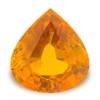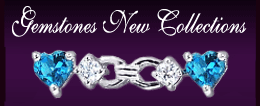Glittering Stones » How to Check a Diamond Is Real or Fake
How to Check a Diamond Is Real or Fake?

If a gift is purchased for someone special, it should be real and have life. Diamonds are for special occasions and for special person. Gift your loved ones with diamonds and check with a diamond appraiser before presenting it. Make sure that the stone purchased is real without causing any damages to the gemstone. Here are some points for you to check whether the stone is real or fake...
Ask for a certificate - Make sure that the stone is from the diamond grading authorities like GIA, AGS, IGI, AGL, EGL or from independent appraisers affiliated with professional organizations. It’s better to ask for a certificate before making a purchase.
Look through Refractive index - Diamonds have high refractive index. Though, the stone is nicely cut, its refractive index will not be reduced as it is its inherent physical property.
Even you can check using techniques i.e. turn the diamond upside down in piece of newspaper if the stone is not mounted and if you can read the print through stone, then there are chances for fake diamonds.
If the gem is mounted and you could not able to see the bottom of the diamond from top, then the diamond is real.
Draw a small dot with on a piece of white paper and place the unmounted diamond in the center of the dot. If the stone is not a diamond, you can see a circular reflection in the stone.
Observe the reflections in the diamond. In a real diamond, the reflection usually manifest in various shades of gray. If it is a fake or low quality diamond, you can see rainbow reflections.
Under the microscope, hold the stone table down. If orange flash is seen through the facets, then the stone is fake.
Weigh the carat weight of the stone. Cubic zirconia weighs approximately 55% more than diamond for the same shape and size. Use a carat scale to compare the weigh of diamonds with other stones.
Setting and mount can also be checked. A real diamond will not be set in a cheap metal. Stamps inside the setting indicate whether it is real gold or platinum and a C.Z stamp indicates that the center stone is not real diamond.
Set the diamond under UV light. Most of the gems exhibit blue fluorescence under an ultra violet or black light. The presence of medium to strong blue confirms that the diamond is real. The absence of blue in a diamond doesn’t mean that it is fake. If you come across very slight green, yellow or gray fluorescence under ultraviolet light, then the gem is moissanite.
Jeweler’s loupe can be used to inspect the diamonds. Usually, most of the mined diamonds have small imperfections or inclusions which can be seen through the loupe. Generally, Cubic zirconia does not have imperfections.
Place the diamond in water. If the gem is real, it will sink and if it is fake it will float.
Diamond testers are available in the market that indicates whether the diamond is true or fake.
Put the stone in the mouth and breathe it. If the stone stays foggy for sometime, then it is fake. Real diamonds will have clear look. Even Cubic zirconia will have clear look, so be careful.
You can even X-Ray the diamonds. A real diamond will not be seen on an x-ray, while cubic zirconia and crystals will have slight radiopaque qualities.
NOVEMBER BIRTHSTONE - CITRINE

COMMEMORATIVE EVENT - 13th Anniversary
KEYWORDS - Success, Abundance, Personal Power
ALSO KNOWN AS - Merchant's stone, Success stone
COLORS - Pale yellow to brown
OCCURRENCE - Brazil
COLOR ZONING - Tiger stripes or Zebra stripes


